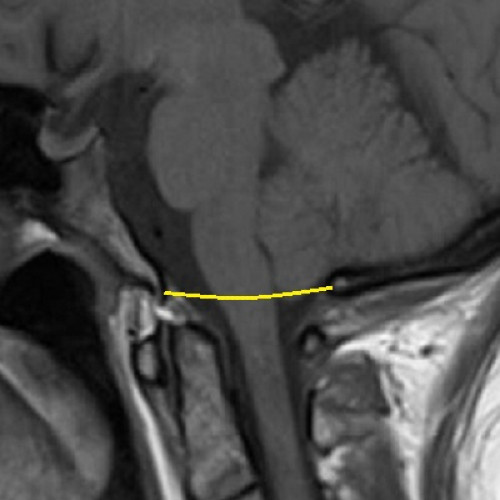Chiari Zero, Explained

An often unrecognized type of Chiari Malformation in which the cerebellum is blocking the foramen magnum, but not descended through it (no herniation), or is less than the 3mm required by the diagnosis criteria.[1] Because of its position, it is blocking the flow of cerebrospinal fluid and consequently, causing a syrinx.[2]
BACKGROUND: In 1997 a study was done on 5 patients that had Syringomyelia (a condition in which a CSF filled cyst forms inside the spinal cord, further compromising the spinal cord itself), but no hindbrain herniation. The presence of the syrinx was indicative of something obstructing the flow of CSF (and four were symptomatic), but because of the lack of cerebellar herniation, they did not fit the criteria for Chiari Malformations.[2][3]
- What they discovered was that the blockage of CSF alone causes problems, even serious ones like Syringomyelia.
- This finding alone demanded a re-evaluation of all they knew about Chiari and the size-based standard adopted for a Chiari 1 malformation.
WHAT HAS CHANGED:
OBSTACLES IN DIAGNOSIS/TREATMENT: This study and studies since have all been very small studies that do not fit the criteria for scientific methods. However, ignoring the presence of a syrinx or pretending that there might be another potential cause for its existence other than the obstruction of cerebrospinal fluid, is negligent at best; while the cause of Syringomyelia is not always a Chiari Malformation, all studies point to it being brought on by some sort of obstruction or disruption of spinal fluid. Many sites claim Chiari Zero as controversial, but the real problem is not that it is controversial, but that medical professionals do not know (or do not known enough) about it.
Diagnosis Requirements: MRI showing no herniation of the cerebellar tonsils through the foramen magnum, but tonsils are low-lying and pressing against the top of the foramen magnum causing a syrinx (despite the name, Chiari Zero is classified under Syringomyelia and not Chiari Malformation – so a syrinx is technically required for diagnoses).
Treatment Options: With few symptoms, non-surgical treatments might be recommended. When a syrinx is present, a decompression is often recommended before the syrinx has a chance to further develop and cause additional damage to the spine. However, even when a syrinx is present, all pathological co-factors should be explored and addressed prior to decompression surgery.
Recommended Doctors: Neurosurgeon
References:
1 “The Chiari Malformations.” edited by R. Shane Tubbs et al., 2nd ed., 9 June 2020.
2 Isik, N, et al. “A New Entity: Chiari Zero Malformation and Its Surgical Method.” Turkish Neurosurgery., U.S. National Library of Medicine, <www.ncbi.nlm.nih.gov/pubmed/21534216>.
3 “JNS JOURNAL OF Neurosurgery OFFICIAL JOURNALS OF THE AANS since 1944.” The Resolution of Syringohydromyelia without Hindbrain Herniation after Posterior Fossa Decompression | Journal of Neurosurgery, Vol 89, No 2, <www.thejns.org/doi/abs/10.3171/jns.1998.89.2.0212?url_ver=Z39.88-2003&rfr_id=ori%3Arid%3Acrossref.org&rfr_dat=cr_pub%3Dpubmed>.
